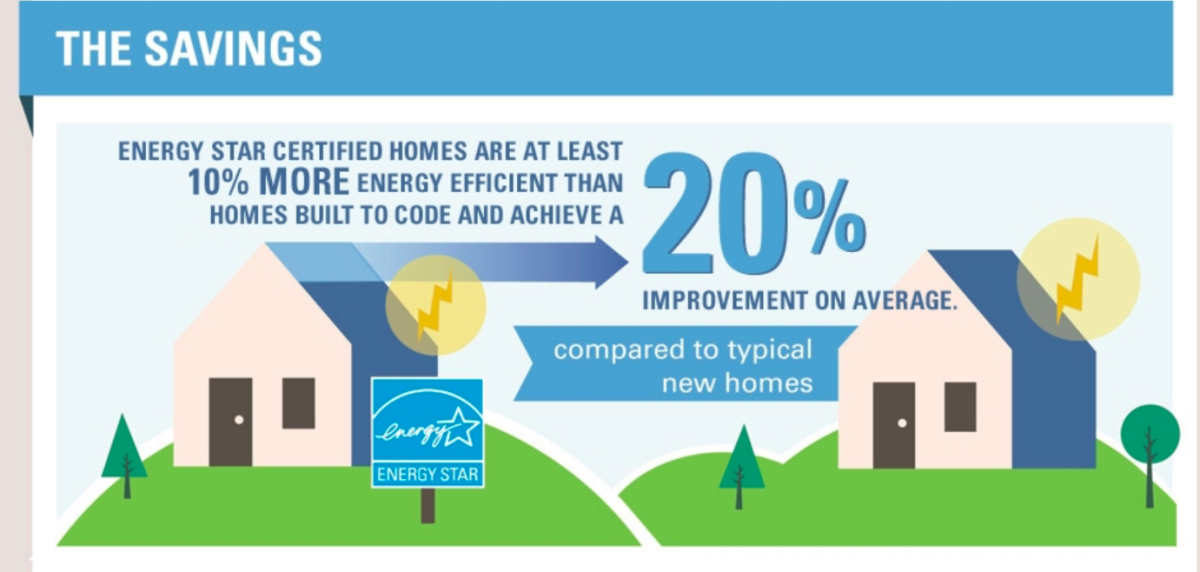7 Benefits of Building an ENERGY STAR Certified Home

02-09-2023
Leading home builders, such as KB Homes and D.R. Horton, have been building ENERGY STAR Homes for a couple of decades. To date, more than 2.3 million new homes and apartments have received ENERGY STAR certification and nearly 4 million have been rated.
ENERGY STAR certified homes are known for being more energy-efficient while providing residents with better quality, performance, and comfort. Now, there’s additional compelling benefits!
As part of the recently passed Inflation Reduction Act, the Section 45L Tax Credit for Energy Efficient New Homes will be specifically tied to ENERGY STAR certification. There is a $2,500 tax credit available for every new ENERGY STAR certified single family home that meets the criteria, files for and is determined qualified for the credit. In addition to single family, manufactured homes can earn $2,500, multifamily can earn $500 or $2500 when prevailing wage requirements are met. These amounts can increase to $5,000 if they meet the criteria, file and qualify as zero energy ready. For those looking to further distinguish their homes there is also the Energy Star Next Gen program available as well.

What are ENERGY STAR certified homes?
ENERGY STAR certified homes save energy, save money and help protect the environment by generating fewer greenhouse gas emissions than non-certified homes. To be certified as ENERGY STAR, a building must meet national program requirements set by the EPA. In addition, there are certain national mandatory measures and some regional program requirements that must be met as well.
Reasons to pursue ENERGY STAR Certification
ENERGY STAR buildings help residents reduce energy use and save money while staying warm and comfortable in their homes.
 Source: EnergyStar.gov
Source: EnergyStar.gov
1. Lower utility bills
The average family spends $2,200 a year on energy bills, much of which goes to heating and cooling. And the cost of home heating is expected to rise another 17 percent this winter.
ENERGY STAR certified homes and apartments are at least 10 percent more energy efficient than those built to code, and achieve a 20 percent improvement on average. The cost savings can be substantial. In 2020 alone, the ENERGY STAR Residential New Construction program helped homeowners save 3 billion kilowatt-hours of electricity and avoid $390 million in energy costs.
2. Decrease greenhouse gas emissions
Because they use less energy, ENERGY STAR certified buildings contribute an average 35 percent fewer greenhouse gas emissions to our atmosphere. By earning the ENERGY STAR Certification, you are helping in the fight against climate change. In 2020, the ENERGY STAR Residential New Construction program helped homeowners reduce 4 million metric tons of greenhouse gas emissions.
3. Improved indoor air quality
The EPA estimates indoor air can be 2-5 times more polluted than outdoor air, and the average American spends 90 percent of their day inside. ENERGY STAR certified Homes reduce dust, pollen, and other allergens through high-performance HVAC, air sealing and air filtration.
4. Year-round comfort
Comprehensive air sealing, insulation, high performance windows and doors, and a high efficiency HVAC system ensure better comfort in every room, year-round.
5. Better resale value
ENERGY STAR certified homes have better resale value if/when it comes time to sell. Studies show a sale price premium of 2-8 percent among energy-efficient rated homes compared to traditional homes.
6. New tax incentives
As part of the recently passed Inflation Reduction Act, the Section 45L Tax Credit for Energy Efficient New Homes will be specifically tied to ENERGY STAR certification. The tax credits previously mentioned will help to offset costs for making these upgrades, which in turn make the homes more valuable and attractive to prospective owners.
Many states and utilities have programs with thousands of dollars of potential extra rebates when constructing energy efficient new homes. Enter your zip code to check for local rebates in ENERGY STAR’s Rebate finder.
7. Get noticed on “Green” Multiple Listing Service
The "green" MLS is an update to the system which includes more information related to a homes “green” features in a listing. This helps agents search for sustainable homes and properties and allows builders and sellers to market their green endeavors.
4 Tips to Achieve for Energy Star Home Certification
To help meet the certification requirements, builders should focus on these areas:
- Meet Grade I insulation -
- Insulation levels should meet or exceed local IECC levels and achieve Grade I installation per RESNET standards. To achieve Grade I, batt insulation must completely fill the cavity on 6 sides, be cut around electrical junction boxes, split around wires and pipes, and avoid compression.
- Use net-and-blow insulation method in walls -
- Use this method of blown-in insulation installation to achieve consistent grade I installs and the highest R-values available in today’s typical framing.

- Air sealing -
- Air leakage accounts for as much as 40 percent of the energy used for heating and cooling in a typical residence. To prevent air leakage, it’s best to seal the building envelope prior to installation of the insulation and the drywall. A “blower door” test is a good way to identify air leakage paths, so that they can be properly sealed.
- Heat pump -
- Heat Pump technology for heating, cooling, water heating and even clothes drying is a great way to further reduce environmental footprint and many ENERGY STAR certified homes will include these technologies. Many models are designed to be very energy-efficient.
How to apply for ENERGY Star Certification
Applications for ENERGY STAR certification must be verified by a third-party provider that meets the requirements for providing ENERGY STAR certification. This includes Certified Raters or Approved Inspectors, as defined by ANSI / RESNET / ICC Standard 301, or an equivalent designation as determined by a Home Certification Organization (HCO) or Multifamily Review Organization (MRO) that have also completed requisite training and earned certificates for the program they will use. More information can be found here.
While certification may seem challenging at first, many builders are not too far from achieving the levels required to become ENERGY STAR certified. At Knauf, we’d love to help you find a solution path to get you over the finish line.
Sources
- https://www.energystar.gov/sites/default/files/asset/document/2021-about-energy-star-homes-508-051322.pdf
- https://www.energy.gov/energysaver/insulation
- https://www.energystar.gov/newhomes/features_benefits/better_resale_value
- 45L Tax Credits for Zero Energy Ready Homes | Department of Energy
- Energy Efficient New Homes | ENERGY STAR Energy Efficient New Homes | ENERGY STAR
